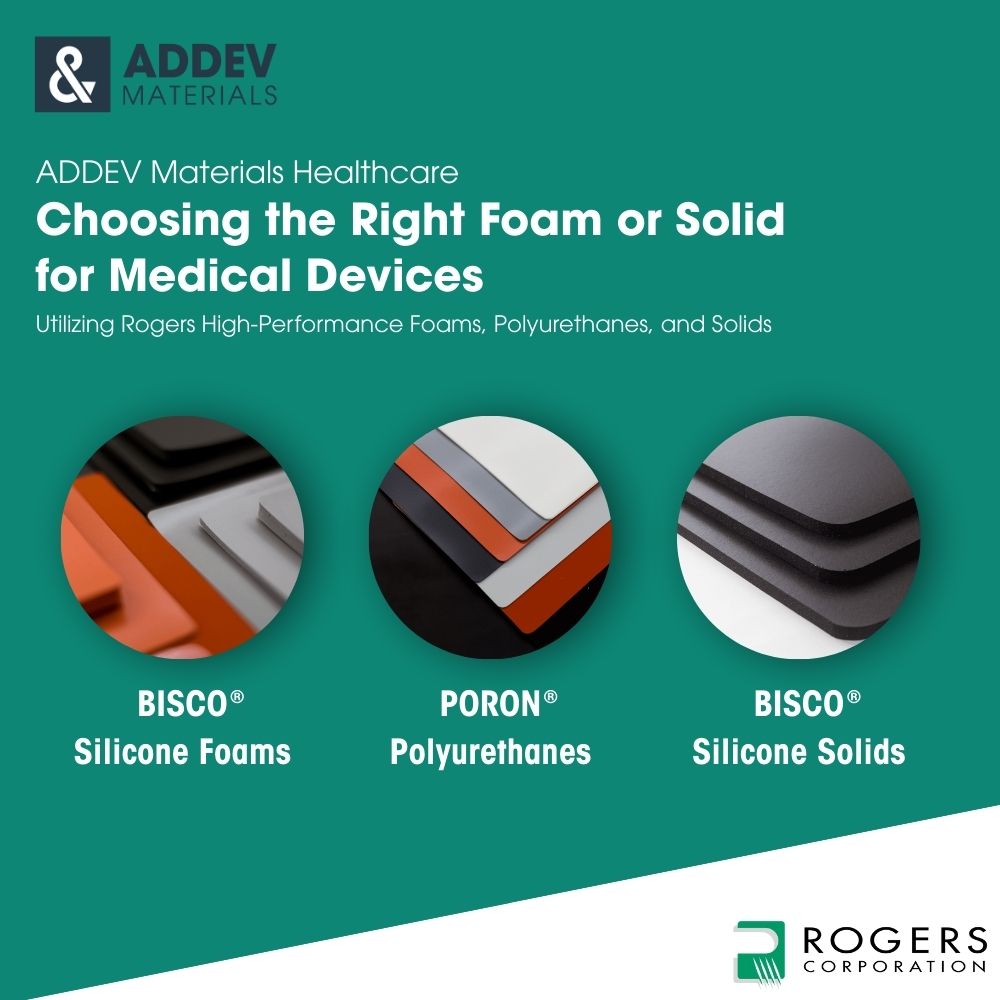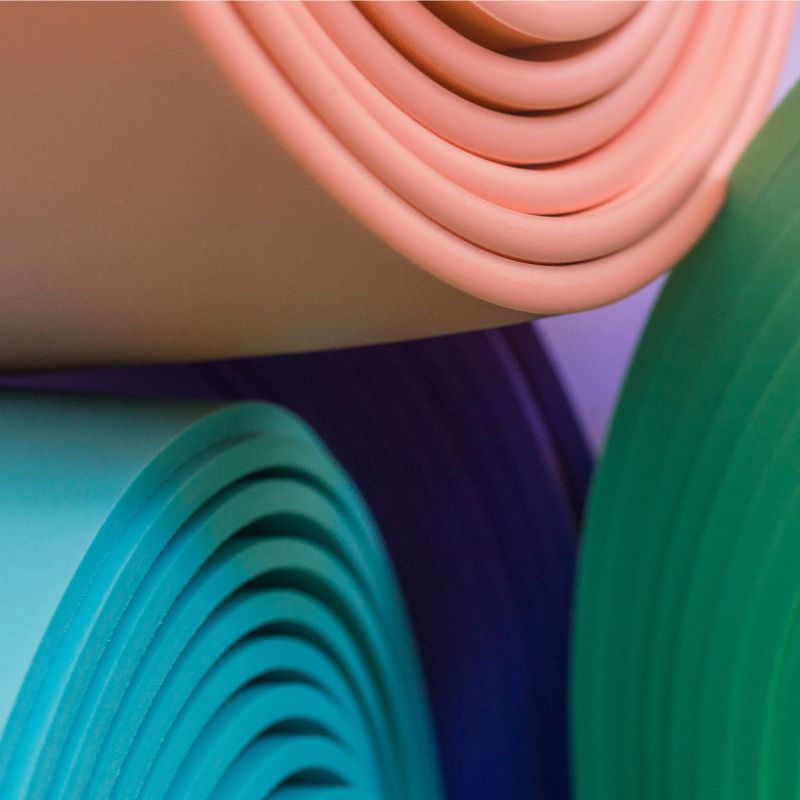In medical device design, the smallest material choice can make the biggest difference. A seal that doesn’t hold, a cushion that breaks down, or a gasket that degrades under sterilization can compromise performance and patient safety. That’s why ADDEV Healthcare partners with Rogers Corporation, a leader in advanced technical materials, to provide reliable foams and solids tailored for healthcare needs.
From wearable comfort layers to precision seals in diagnostic equipment, choosing the right Rogers material starts with knowing the distinctions between them. Here’s a clear look at the three main product families. BISCO® silicone foams, PORON® polyurethanes, and BISCO® silicone solids.
BISCO® Silicone Foams
What They Are
BISCO silicone foams are open-cell, platinum-cured silicones engineered for long-term sealing, cushioning, and protection. They stand out for their durability under extreme conditions. BISCO foams:
- Resist compression set, maintaining seal performance over time
- Function across a wide temperature range (-55°C to 200°C)
- Resist UV, ozone, and repeated exposure to hospital disinfectants
- Select grades meet USP Class VI and ISO 10993 for biocompatibility
The BISCO MS Series takes this further, meeting stricter requirements for medical and life science applications.
When to Choose BISCO Silicone Foams
BISCO foams are ideal when designs need:
- Seals that withstand fluids, dust, or environmental exposure
- Materials that stay stable during temperature cycling or chemical cleaning
- Noise and vibration control in sensitive equipment
- Comfort cushioning in patient-contact devices
Where BISCO Foams are Found
- Gasketing in diagnostic and medical electronics
- Seals in PCR thermal cyclers and in vitro diagnostic systems
- Vibration damping in respiratory devices
- Cushioning for delicate glassware and instruments
- Seals for cold chain packaging and transport

PORON® Polyurethanes
PORON polyurethanes are microcellular foams valued for consistent cushioning, shock absorption, and dimensional stability. Unlike silicone foams, they are softer and thinner, making them excellent for applications where comfort or precision spacing is critical. Rogers offers both industrial and medical-grade PORON formulations, with medical versions designed for direct patient contact and ISO 10993 compliance.
When to Choose PORON Polyurethanes
PORON polyurethanes are the right fit when you need:
- Soft, thin cushioning layers that won’t flatten over time
- Excellent dimensional stability for precision assemblies
- Patient-contact safe materials (medical grades)
- A wide range of firmness levels to fine-tune performance
Where PORON Polyurethanes are Found
- Industrial uses:
- Gaskets and seals in medical electronics
- Display assemblies
- Preventing dust
- Light leakage
- Vibration
- Medical uses:
- Orthotics and prosthetics for comfort and impact absorption
- Cushioning layers in wearable medical devices
- Support layers in wound care dressings

Medical PORON foam vs. Industrial PORON foam: What’s the difference?
At their core, both medical and industrial PORON foams deliver the same benefits: consistent cushioning, impact protection, and long-term dimensional stability. The difference lies in how and where they’re used, what products are available, and the level of testing required.
- Component location and skin contact – Industrial PORON foam is designed for internal components such as gaskets or dust seals that don’t come into contact with the patient. Medical PORON foam, on the other hand, is engineered for direct skin contact in wearables, orthotics, and wound care dressings.
- Product offerings – Rogers offers specific medical-grade PORON formulations optimized for comfort, flexibility, and biocompatibility, while industrial PORON formulations focus on sealing, gasketing, and equipment protection.
- Testing and compliance – Medical PORON materials undergo more rigorous testing to ensure safety for skin contact, including ISO 10993 biocompatibility evaluations, whereas industrial PORON materials do not require the same level of regulatory certification.
BISCO® Silicone Solids
What They Are
BISCO silicone solids are platinum-cured, peroxide-free materials designed for robust sealing performance. Unlike foams, these are solid silicones — making them ideal when maximum sealing integrity is required. They’re chemically inert, stable under sterilization, and many grades meet USP Class VI and 21CFR177.2600 standards.
When to Choose BISCO Silicone Solids
BISCO solids are best when your design requires:
- High-integrity seals with minimal compression loss
- Chemically inert materials for sensitive reagents or fluids
- Reliability under repeated sterilization or thermal cycling
- Full compliance with stringent medical and life science regulations
Where BISCO Silicone Solids are Found
- Seals in medical-grade filtration systems
- Diagnostic sealing in PCR thermal cyclers
- Precision gaskets in laboratory and life sciences equipment
Choosing with Confidence
The choice between a foam or a solid — and between silicone and polyurethane — depends on the balance of sealing performance, cushioning, chemical resistance, and regulatory compliance your device requires.
At ADDEV Healthcare, we help engineers and device manufacturers navigate these decisions by matching Rogers advanced materials to the specific challenges of healthcare applications. Whether it’s extending the life of a wearable sensor, protecting fragile instruments in transport, or ensuring flawless sealing in diagnostic equipment, the right choice of foam or solid can make all the difference.
Why Choose ADDEV Healthcare for Foam & Solid Converting?
In medical device design, precision and reliability are non-negotiable. That’s why ADDEV Healthcare partners with Rogers Corporation to convert and die cut advanced materials like BISCO silicone foams, PORON polyurethanes, and BISCO silicone solids—each engineered to solve complex design challenges. From cushioning layers in wearables to high-integrity seals in diagnostic systems, our converting expertise ensures every component performs under pressure.
- Expert die-cutting, kiss-cutting, slitting, and multi-layer lamination
- Material selection support for biocompatibility, durability, and sealing integrity
- Cleanroom converting with ISO 13485:2016 certified processes
- Access to Rogers medical-grade materials including USP Class VI and ISO 10993 compliant foams and solids

